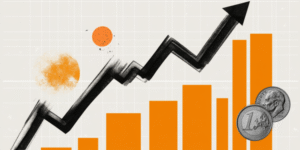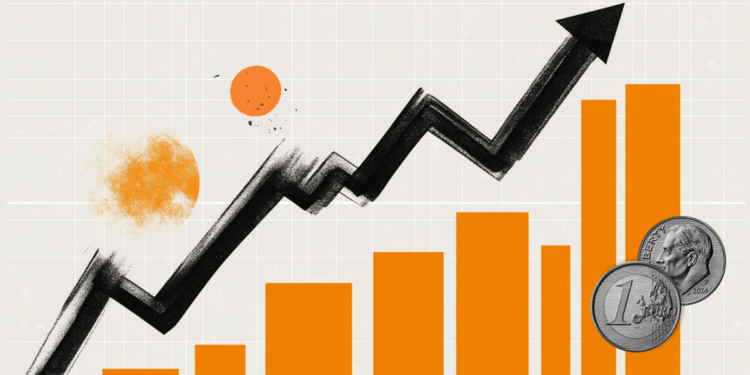Annual inflation in Germany, as measured by the change in the Consumer Price Index (CPI), rose to 2.2% in August from 2% in July, Germany’s Federal Statistical Office reported on Friday. This print came in above the market expectation of 2.1%. On a monthly basis, the CPI rose by 0.1%.
The Harmonized Index of Consumer Prices (HICP), the European Central Bank’s (ECB) preferred gauge of inflation, rose by 0.1% and 2.1% on a monthly and yearly basis, respectively.
Market reaction to German inflation data
EUR/USD recovers slightly from session lows and was last seen trading at 1.1670, losing 0.1% on a daily basis.
Euro Price This week
The table below shows the percentage change of Euro (EUR) against listed major currencies this week. Euro was the weakest against the Australian Dollar.
| USD | EUR | GBP | JPY | CAD | AUD | NZD | CHF | |
|---|---|---|---|---|---|---|---|---|
| USD | 0.46% | 0.37% | 0.18% | -0.46% | -0.67% | -0.41% | -0.06% | |
| EUR | -0.46% | -0.09% | -0.34% | -0.91% | -1.06% | -0.87% | -0.51% | |
| GBP | -0.37% | 0.09% | -0.42% | -0.82% | -1.03% | -0.77% | -0.43% | |
| JPY | -0.18% | 0.34% | 0.42% | -0.56% | -0.80% | -0.50% | -0.10% | |
| CAD | 0.46% | 0.91% | 0.82% | 0.56% | -0.20% | 0.08% | 0.40% | |
| AUD | 0.67% | 1.06% | 1.03% | 0.80% | 0.20% | 0.26% | 0.60% | |
| NZD | 0.41% | 0.87% | 0.77% | 0.50% | -0.08% | -0.26% | 0.35% | |
| CHF | 0.06% | 0.51% | 0.43% | 0.10% | -0.40% | -0.60% | -0.35% |
The heat map shows percentage changes of major currencies against each other. The base currency is picked from the left column, while the quote currency is picked from the top row. For example, if you pick the Euro from the left column and move along the horizontal line to the US Dollar, the percentage change displayed in the box will represent EUR (base)/USD (quote).
This section below was published as a preview of the German inflation data at 05:00 GMT.
- The Federal Statistical Office of Germany will publish the inflation data on Friday at 12:00 GMT.
- Headline CPI is set to rise 2.1% YoY in August, a tad higher than the prior increase of 2%.
- German inflation data is often seen as a precursor to the Eurozone figures, impacting the ECB’s easing outlook.
The Federal Statistical Office of Germany (Destatis) will publish the country’s preliminary estimate of the Harmonized Index of Consumer Prices (HICP) inflation data for August on Friday at 12:00 GMT.
German inflation data usually provides clues to Eurozone figures and also helps markets gauge the European Central Bank’s (ECB) path forward on interest rates. The central bank’s inflation target is 2.0%.
The EUR/USD pair is expected to experience volatility in the case of any surprises in the German inflation report.
What to expect in the next German inflation report?
The headline annual German Consumer Price Index (CPI) is expected to rise 2.1% in August, up from a 2% increase reported in July. The monthly CPI inflation is set to show no growth, cooling off from a 0.3% increase in the previous period.
Meanwhile, the HICP inflation is expected to tick up to 2% year-over-year (YoY) in August from 1.8% in July. Monthly, the core HICP is seen stagnating in August, compared with a 0.4% acceleration in the previous month.
Previewing the August inflation data, analysts at TD Securities (TDS) explain: “July’s print surprised to the downside due to a rounding effect at 1.845%. We expect Aug to start climbing back to target as energy deflation moderates due to base effects and increases in gas and electricity prices.”
“Services should also reverse the July weakness. This should alleviate concerns of a persistent inflation undershoot in the euro area’s largest economy,” analysts at TDS noted.
Additionally, the regional inflation data points provide hints on the nationwide headline German reading for August.
North Rhine-Westphalia (NRW) is the first German state to report August inflation readings and, as it is the most populous state, the readings can often be a signal of the trend in the figure for the whole of Germany. However, these figures don’t always work well as a forward-looking indicator.
Meanwhile, Spain is also due to publish its national inflation figures for August on Friday, which will further help offer clues about the direction of the German, as well as the whole Eurozone HICP data.
How could the German HICP inflation affect EUR/USD?
At the press conference following the July policy meeting, ECB President Christine Lagarde said, “risks to economic growth remain tilted to the downside” and “the outlook for euro area inflation is more uncertain than usual.”
Last week at Jackson Hole Symposium, Lagarde noted that “Europe’s labor market has performed far better than expected, despite soaring inflation and steep interest-rate hikes in recent years,” per Reuters.
In light of the uncertain euro area growth and inflation outlook and a widely anticipated ECB interest rate cut pause next month, the upcoming HICP inflation data from Germany (on Friday) and the Eurozone (next Tuesday) will be key in determining whether the central bank will resume easing after the September meeting.
A hotter-than-expected headline and core HICP inflation data could reinforce expectations for an extended pause by the ECB beyond September. In such a case, EUR/USD could find fresh demand, initiating an advance toward the 1.1700 level.
However, if inflation in the Eurozone’s economic powerhouse unexpectedly slows down, it would reinforce the ECB’s easing expectations. Subsequently, the main currency pair could resume the downside toward the 1.1500 region.
Dhwani Mehta, Asian Session Lead Analyst at FXStreet, offers a brief technical outlook for the major and explains:
“EUR/USD has managed to defend the 21-day Simple Moving Average (SMA) support on Thursday, keeping the bullish momentum alive despite the latest downtick. The 14-day Relative Strength Index (RSI) holds above the midline, currently near 51, justifying the positive outlook in the near term.”
Dhwani also outlines a few important technical levels to trade the EUR/USD pair: “If the ongoing retreat picks up pace, the August 27 low of 1.1574 could align as the immediate support. A sustained move below the level will expose the August 5 low at 1.1528, followed by the 100-day SMA at 1.1505. Conversely, buyers need to clear the 1.1700 resistance area to challenge the three-week highs near 1.1750. The July 24 high of 1.1789 will be the last line of defense for sellers.”
Inflation FAQs
Inflation measures the rise in the price of a representative basket of goods and services. Headline inflation is usually expressed as a percentage change on a month-on-month (MoM) and year-on-year (YoY) basis. Core inflation excludes more volatile elements such as food and fuel which can fluctuate because of geopolitical and seasonal factors. Core inflation is the figure economists focus on and is the level targeted by central banks, which are mandated to keep inflation at a manageable level, usually around 2%.
The Consumer Price Index (CPI) measures the change in prices of a basket of goods and services over a period of time. It is usually expressed as a percentage change on a month-on-month (MoM) and year-on-year (YoY) basis. Core CPI is the figure targeted by central banks as it excludes volatile food and fuel inputs. When Core CPI rises above 2% it usually results in higher interest rates and vice versa when it falls below 2%. Since higher interest rates are positive for a currency, higher inflation usually results in a stronger currency. The opposite is true when inflation falls.
Although it may seem counter-intuitive, high inflation in a country pushes up the value of its currency and vice versa for lower inflation. This is because the central bank will normally raise interest rates to combat the higher inflation, which attract more global capital inflows from investors looking for a lucrative place to park their money.
Formerly, Gold was the asset investors turned to in times of high inflation because it preserved its value, and whilst investors will often still buy Gold for its safe-haven properties in times of extreme market turmoil, this is not the case most of the time. This is because when inflation is high, central banks will put up interest rates to combat it.
Higher interest rates are negative for Gold because they increase the opportunity-cost of holding Gold vis-a-vis an interest-bearing asset or placing the money in a cash deposit account. On the flipside, lower inflation tends to be positive for Gold as it brings interest rates down, making the bright metal a more viable investment alternative.
Read the full article here



